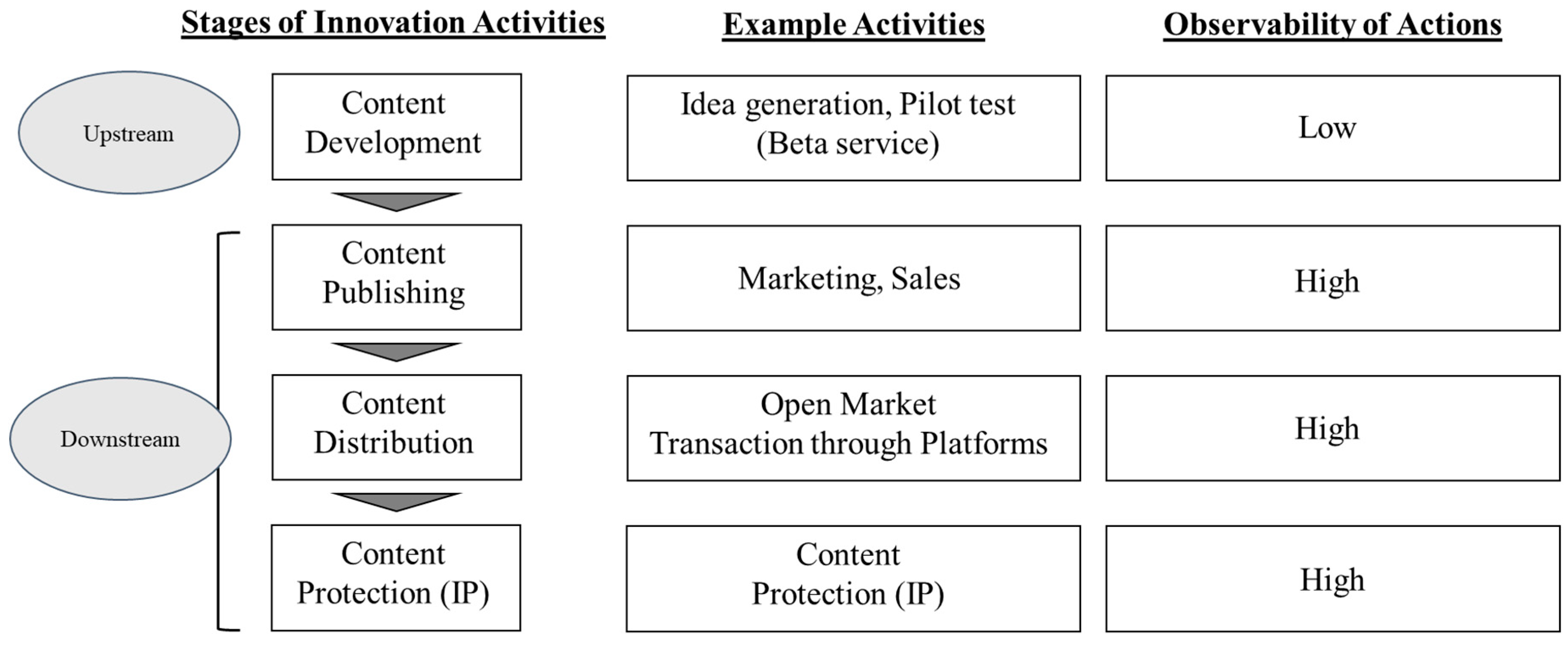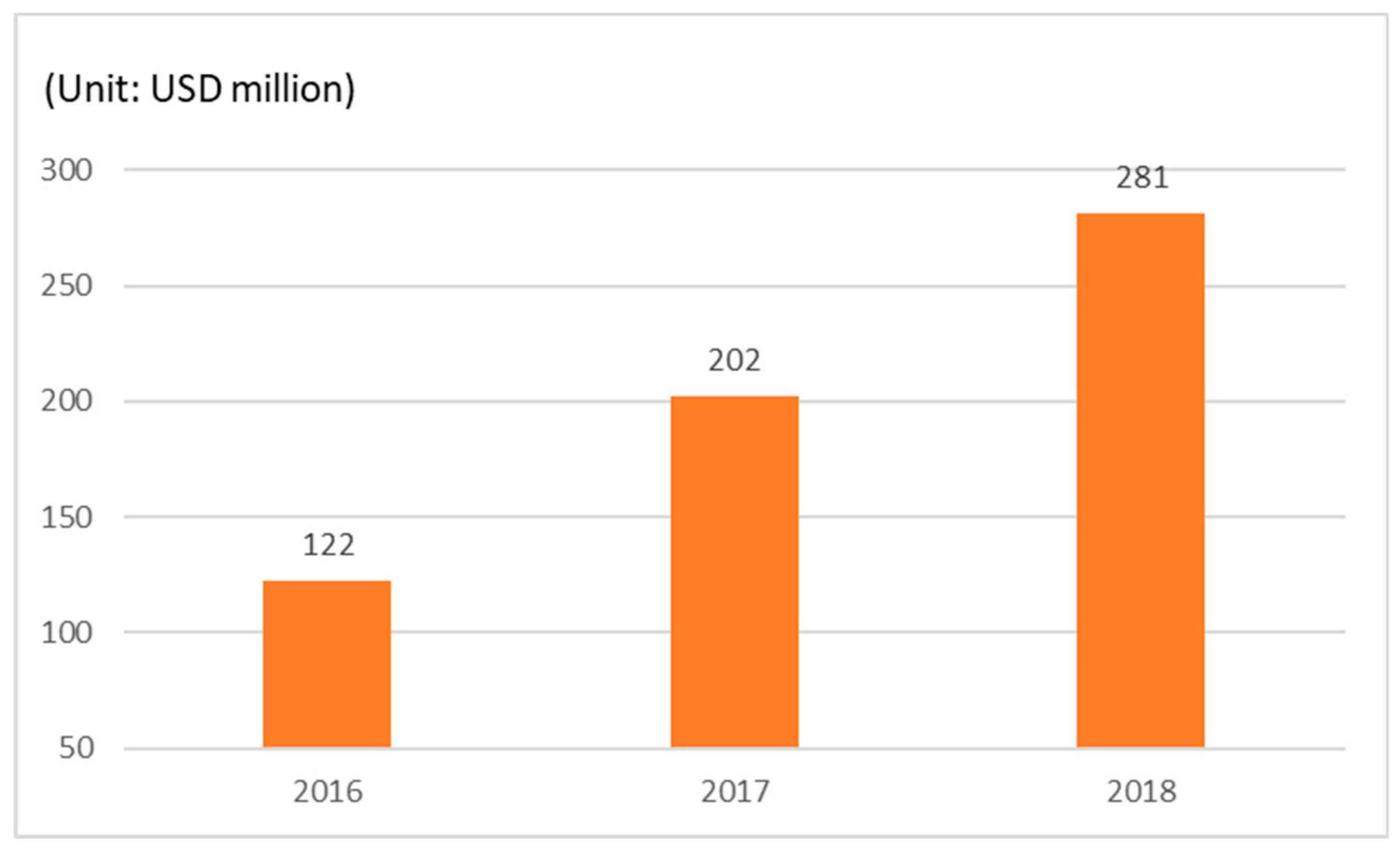The Impact of Multimarket Competition on Innovation Strategy: Evidence from the Korean Mobile Game Industry
Abstract
1. Introduction
1.1. Research Questions
1.2. Research Scope and Method
2. Theoretical Background and Framework
2.1. Concept of Multimarket Contact (MMC)
2.2. MMC and Mutual Forbearance
2.3. Stages of Innovation Activities and Observability of Competitive Actions
2.4. Stages of Innovation Activities in the Mobile Game Industry
3. Research Context
3.1. Overview of the Korean Mobile Game Market
3.2. Netmarble
3.3. NCSoft
3.4. Comparison between Netmarble and NCSoft
4. Findings
4.1. Multipoint Competition between Two Firms
4.2. Content Development Stage
4.3. Commercialization Stage (Publishing and Distribution)
4.4. IP Rights Protection Strategy
4.5. Summary of Findings
5. Discussion
5.1. Intended Theoretical Contributions
5.2. Limitation and Avenues for Future Research
6. Conclusions
6.1. Implications for Open Innovation Studies
6.2. Implications for Managers
Author Contributions
Funding
Conflicts of Interest
References
- Yu, T.; Cannella, A.A., Jr. A comprehensive review of multimarket competition research. J. Manag. 2013, 39, 76–109. [Google Scholar] [CrossRef]
- Kang, W.; Bayus, B.L.; Balasubramanian, S. The strategic effects of multimarket contact: Mutual forbearance and competitive response in the personal computer industry. J. Mark. Res. 2010, 47, 415–427. [Google Scholar] [CrossRef]
- Theeke, M.; Lee, H. Multimarket Contact and Rivalry over Knowledge-based Resources. Strateg. Manag. J. 2017, 38, 2508–2531. [Google Scholar] [CrossRef]
- Williams, D. Structure and competition in the US home video game industry. Int. J. Media Manag. 2002, 4, 41–54. [Google Scholar] [CrossRef]
- Langley, A. Strategies for theorizing from process data. Acad. Manag. Rev. 1999, 24, 691–710. [Google Scholar] [CrossRef]
- Eisenhardt, K.M. Building theories from case study research. Acad. Manag. Rev. 1989, 14, 532–550. [Google Scholar] [CrossRef]
- Korn, H.J.; Baum, J.A. Chance, imitative, and strategic antecedents to multimarket contact. Acad. Manag. J. 1999, 42, 171–193. [Google Scholar]
- Chen, M.-J.; Miller, D. Competitive dynamics: Themes, trends, and a prospective research platform. Acad. Manag. Ann. 2012, 6, 135–210. [Google Scholar] [CrossRef]
- Gimeno, J.; Woo, C.Y. Multimarket contact, economies of scope, and firm performance. Acad. Manag. J. 1999, 42, 239–259. [Google Scholar]
- Greve, H.R. Multimarket contact and sales growth: Evidence from insurance. Strateg. Manag. J. 2008, 29, 229–249. [Google Scholar] [CrossRef]
- Gimeno, J. Reciprocal threats in multimarket rivalry: Staking out ‘spheres of influence’in the US airline industry. Strateg. Manag. J. 1999, 20, 101–128. [Google Scholar] [CrossRef]
- Anand, J.; Mesquita, L.F.; Vassolo, R.S. The dynamics of multimarket competition in exploration and exploitation activities. Acad. Manag. J. 2009, 52, 802–821. [Google Scholar] [CrossRef]
- Porter, M.E. Towards a dynamic theory of strategy. Strateg. Manag. J. 1991, 12, 95–117. [Google Scholar] [CrossRef]
- Glynn, M.A.; Lounsbury, M. From the critics’ corner: Logic blending, discursive change and authenticity in a cultural production system. J. Manag. Stud. 2005, 42, 1031–1055. [Google Scholar] [CrossRef]
- Hirsch, P.M. Cultural industries revisited. Org. Sci. 2000, 11, 356–361. [Google Scholar] [CrossRef]
- Candy Crush Saga Creator King Gets Greedy and Trademarks the Word ‘Candy’. Available online: https://www.independent.co.uk/life-style/gadgets-and-tech/candy-crush-saga-creators-king-get-greedy-and-trademark-the-word-candy-9074902.html (accessed on 23 January 2020).
- Korea Creative Content Agency. Korea Content Industry Report; Korea Creative Content Agency: Naju, South Korea, 2018. [Google Scholar]
- Financial Supervisory Service. Netmarble Annual Report; Financial Supervisory Service: Seoul, South Korea, 2018. [Google Scholar]
- Financial Supervisory Service. NCSoft Annual Report; Financial Supervisory Service: Seoul, South Korea, 2018. [Google Scholar]
- McGrath, R.G.; Chen, M.-J.; MacMillan, I.C. Multimarket maneuvering in uncertain spheres of influence: Resource diversion strategies. Acad. Manag. Rev. 1998, 23, 724–740. [Google Scholar] [CrossRef]
- Mas-Ruiz, F.; Ruiz-Moreno, F. Rivalry within strategic groups and consequences for performance: The firm-size effects. Strateg. Manag. J. 2011, 32, 1286–1308. [Google Scholar] [CrossRef]
- Chesbrough, H.; Crowther, A.K. Beyond high tech: Early adopters of open innovation in other industries. R & D Manag. 2006, 36, 229–236. [Google Scholar]
- Han, J.; Cho, O. Platform business Eco-model evolution: Case study on KakaoTalk in Korea. J. Open Innov. Technol. Mark. Complex. 2015, 1, 6. [Google Scholar] [CrossRef]
- Della Corte, V. Innovation through Coopetition: Future Directions and New Challenges. J. Open Innov. Technol. Mark. Complex. 2018, 4, 47. [Google Scholar] [CrossRef]
- Yun, J.J.; Zhao, X.; Yigitcanlar, T.; Lee, D.; Ahn, H. Architectural design and open innovation symbiosis: Insights from research campuses, manufacturing systems, and innovation districts. Sustainability 2018, 10, 4495. [Google Scholar] [CrossRef]
- Nonaka, I. A dynamic theory of organizational knowledge creation. Org. Sci. 1994, 5, 14–37. [Google Scholar] [CrossRef]
- Park, N.K.; Mezias, J.M.; Lee, J.; Han, J.-H. Reverse knowledge diffusion: Competitive dynamics and the knowledge seeking behavior of Korean high-tech firms. Asia Pac. J. Manag. 2014, 31, 355–375. [Google Scholar] [CrossRef]
- Yun, J.J.; Lee, M.; Park, K.; Zhao, X. Open innovation and serial entrepreneurs. Sustainability 2019, 11, 5055. [Google Scholar] [CrossRef]
- Yun, J.J.; Won, D.; Park, K. Entrepreneurial cyclical dynamics of open innovation. J. Evol. Econ. 2018, 28, 1151–1174. [Google Scholar] [CrossRef]
- Ryu, W.; Reuer, J.J.; Brush, T.H. The effects of multimarket contact on partner selection for technology cooperation. Strateg. Manag. J. 2019, 41, 267–289. [Google Scholar] [CrossRef]
- Amabile, T.M. A model of creativity and innovation in organizations. Res. Organ. Behav. 1988, 10, 123–167. [Google Scholar]
- Woodman, R.W.; Sawyer, J.E.; Griffin, R.W. Toward a theory of organizational creativity. Acad. Manag. Rev. 1993, 18, 293–321. [Google Scholar] [CrossRef]
- Yun, J.J.; Won, D.; Park, K.; Jeong, E.; Zhao, X. The role of a business model in market growth: The difference between the converted industry and the emerging industry. Techonol. Foreacsting Soc. 2019, 146, 534–562. [Google Scholar] [CrossRef]



| Examples | Observability by Rivals | Likelihood of Mutual Forbearance | Likelihood of Retaliatory Actions by Rivals | |
|---|---|---|---|---|
| Upstream activities | R&D, New Product, Development | Low | Low | High |
| Downstream activities | Sales Operation, Distribution | High | High | Low |
| Netmarble | NCSoft | |
|---|---|---|
| FY 2018 | FY 2018 | |
| Total Asset (US$ million) | 5433 | 2941 |
| Sales (US$ million) | 2021 | 1715 |
| Operating Profit (US$ million) | 241 | 614 |
| Net Income (US$ million) | 214 | 421 |
| Main Game Genre | MMORPG | MMORPG |
| Key Strategy | Partnership with other developers/publishers | Exploitation of its own IP, In-house development |
| Key Market | Korea, Japan, China | Korea, Japan, China |
| List of Game Product Genre As of 2019 | ||
|---|---|---|
| Number of Game Product Genre | Netmarble (9) | MMORPG (Massively Multiplayer Online Role-Playing Game), Action RPG, Action Strategy RPG, RPG, Board Game, Catching RPG, Poker, MOBA (Multiplayer Online Battle Arena), Sports |
| NCSoft (4) | MMORPG, RPG, Sports, Puzzle | |
| Game Product Genre Overlap (3) | MMORPG, RPG, Sports | |
| Trademark | Patent | |||
|---|---|---|---|---|
| Domestic | Overseas | Domestic | Overseas | |
| Enrolled | 232 | 131 | 12 | 1 |
| Filed | 34 | 42 | 25 | 6 |
| Content Development (Low Observability) | Content Commercialization (High Observability) | Content Protection (High Observability, Mutual Forbearance was Nullified) | |
|---|---|---|---|
| High Mutual Forbearance (Korea) | Cooperative Action: Co-development | Cooperative Action: Joint marketing, promotion | Competitive Action: IPR, Trademark, and Patent filing Activities |
| Low Mutual Forbearance (Japan, China) | Competitive Action: IP Acquisition | Competitive Action: Local Partnership | Competitive Action: IPR, Trademark, and Patent filing Activities |
© 2020 by the authors. Licensee MDPI, Basel, Switzerland. This article is an open access article distributed under the terms and conditions of the Creative Commons Attribution (CC BY) license (http://creativecommons.org/licenses/by/4.0/).
Share and Cite
Lee, J.; Park, J.S.; Lee, J. The Impact of Multimarket Competition on Innovation Strategy: Evidence from the Korean Mobile Game Industry. J. Open Innov. Technol. Mark. Complex. 2020, 6, 14. https://doi.org/10.3390/joitmc6010014
Lee J, Park JS, Lee J. The Impact of Multimarket Competition on Innovation Strategy: Evidence from the Korean Mobile Game Industry. Journal of Open Innovation: Technology, Market, and Complexity. 2020; 6(1):14. https://doi.org/10.3390/joitmc6010014
Chicago/Turabian StyleLee, Jinju, Jin Suk Park, and Jeonghwan Lee. 2020. "The Impact of Multimarket Competition on Innovation Strategy: Evidence from the Korean Mobile Game Industry" Journal of Open Innovation: Technology, Market, and Complexity 6, no. 1: 14. https://doi.org/10.3390/joitmc6010014
APA StyleLee, J., Park, J. S., & Lee, J. (2020). The Impact of Multimarket Competition on Innovation Strategy: Evidence from the Korean Mobile Game Industry. Journal of Open Innovation: Technology, Market, and Complexity, 6(1), 14. https://doi.org/10.3390/joitmc6010014









